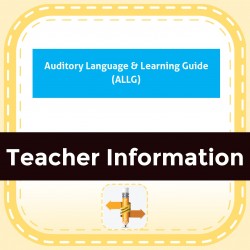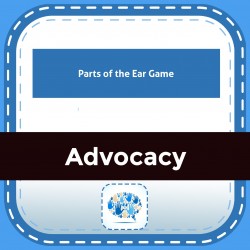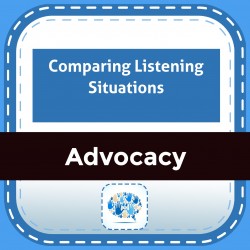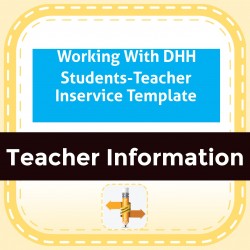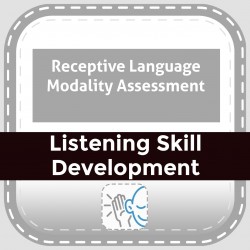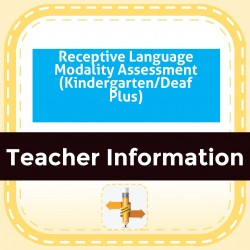Categories
Resource Types
CCSS
Speaking & Listening
Language
Reading
Auditory Language & Learning Guide (ALLG)
$ 10
The Auditory Language & Learning Guide is an EXCELLENT informal evaluation tool for listening and language that can be used with students of any age and language ability. The 2 page checklist format e
...
asily allows the teacher to develop IEP goals based on identified student weaknesses in the 4 areas of audition/listening, receptive language, expressive language, and social communication. Skills can be rated as 'targeted', 'emerging', 'mastered' or 'previously assessed' and checked off by date achieved. This assessment tool can be used from year to year allowing instructors and parents to see growth in a students language and learning.
Parts of the Ear Game
$ 5
This is a fun digital learning activity for a student to review the 3 parts of the ear. The learner identifies the function of each part, what is in each part and uses a diagram to identify parts of t
...
he ear.There are very few digital learning activities available today. Advocacy practice for students with hearing loss includes learning about hearing. As students begin to learn how they ear, identifying the 3 parts of the ear is a first step. They need lots of practice labeling different parts of the ear and identifying how they help with hearing. Learning Objective:1. The student will be able to identify functions of the 3 parts of the ear. 2. Given a diagram, the student will label the part of the ear.
Comparing Listening Situations
$ 5
This interactive Google Slides activity asks students to evaluate 4 listening situations (presented in pictures and short descriptions) and rate them on a scale according to listening difficulty. Afte
...
r rating the situations, students are tasked with providing an explanation of why each situation is difficult or easy to hear. This would be a great 'stepping off' activity to begin a unit on coping skills or to evaluate how a student perceives different situations and why/how he/she feels about his/her listening abilities.There is very little digital learning activities available for remote learning today. This tool that asks students to rate situations that are difficult or easy to hear encourages introspection about a student's hearing loss. Asking student to explain why the situation is easy or hard to hear encourages them to evaluate their own listening skills and how advocacy can improve even the most difficult situation.Learning Objective:The student will be able to compare listening situations by rating them on a scale from easy to hear to hear. The student will be able to describe why a specific listening situation is difficult or easy to hear, giving support for their answers.
Working With DHH Students-Teacher Inservice Template
$ 3
It's the beginning of the year and time again to talk to those mainstream teachers and staff members about the students with hearing loss. Wouldn't it be nice to have a cool powerpoint or slides prese
...
entation with visuals and links? Well, here you are!! This is a template you can use "as is", or customize to your specific program. It has links to hearing loss simulations, comments on captioning and ideas from the Deaf community all ready for you to share!
Receptive Language Modality Assessment
$ 2
How much do your students comprehend when given information through total communication? Do they understand information better in noise? What about information given verbally only? If you want clear c
...
ut data on their best receptive language mode, then this is the tool for you!! The teacher/clinician reads 4 short passages and asks questions in different modes of communication-total communication, sign language, orally with noise and orally without noise. (Free passages and questions are available on readworks.org and k5learning.org). After scoring the student's answers, conclusions can be drawn about a student's preferred receptive language modality. This data can be used to justify interpreter services, the need for DHH instruction or to give accommodations for noisy classroom situations.
Receptive Language Modality Assessment (Kindergarten/Deaf Plus)
$ 2
How much do your students comprehend when given information through total communication? Do they understand information better in noise? What about information given verbally only? If you want clear c
...
ut data on their best receptive language mode, then this is the tool for you. The teacher/clinician shows the student 6 pictures in a category (animals, food, etc). She names pictures in each category using different modes of communication and with/without background noise. Students show what they understand by circling or crossing off the pictures and conclusions can be drawn about a child's receptive language modality. This information can be used to justify interpreter services, the need for DHH instruction or give accommodations for difficulties with noise in a classroom.

 Your browser is out of date. For best experience switch to latest updated Browser.
Your browser is out of date. For best experience switch to latest updated Browser.
 Get Chrome
Get Chrome Get Edge
Get Edge Get Firefox
Get Firefox
